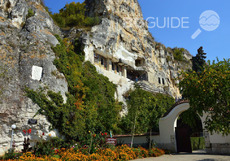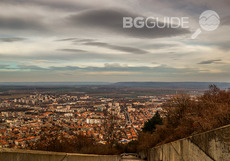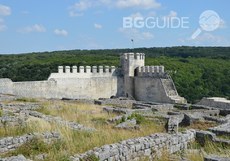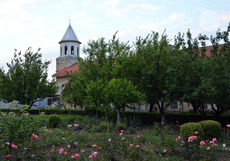Скален манастир "Св. Димитър Басарбовски"
Единственият действащ скален манастир в България се намира в близост до гр. Русе.
The story of unforgettable times and beautiful nature, spread out on the lands of Ludogorie
In the eastern part of the Danubian plain, before to reach the region of Dobrudzha, is expanding the Ludogorie. For mysterious reasons and ways in this area are skillfully intertwined natural resources and rich cultural and historical heritage. Every city and village here can be a starting point for a journey in the past or in the majestic nature. Visits naturally and almost necessarily pass through the Sboryanovo Historical and Archeological Reserve with the Thracian Tomb in the village of Sveshtari, Demir Baba Teke, the Hellenic capital Helis and more than 140 registered archaeological sites in it, the Archaeological Reserve Abritus, the Ethnographic Complex in the village of Pobit Kamak, Voden Reserve and where else. The list of places of interest is a long one. This part of Bulgaria may not be among the most popular tourist spots, but it has all the merits and reasons for being one.
Undoubtedly, the most famous is the Thracian tomb near the village of Sveshtari. It is dated to the IV-III centuries BC. It has remarkable dimensions, original architecture and decoration, which ranked it on the UNESCO World Heritage List.
With all its hundreds of sites, it is worth visiting the Sboryanovo Historical and Archaeological Reserve itself. In addition to the many settlements, shrines and necropolises of antiquity, this place has a number of natural features - rare animal and plant species, remarkable landscapes.
Even the Voden Reserve, extremely rich in flora and fauna, contains archeological and historical sites from the end of the 1st millennium BCE. The clear waters of the dams, centuries-old forests, impressive hunting, fishing and recreation conditions make the reserve one of the most visited sites in the region. It is located near the village of Sveshtari, 10 km from the town of Isperih. Perhaps the most attractive animal species here are the aurochs, or also known as bison. The black stork, which unexpectedly shrinks nests in the area, is in no way inferior to it.
We have mentioned a large part of the historical, natural and archeological sites in the region. But they are only a small part of what can be seen and learned here. Such places are not missing in the towns themselves. For example, Razgrad is among the remains of prehistoric settlements, Thracian tombstones and the Roman fortress “Abritus”. And in the architectural district "Varosha" are preserved unique Revival houses, as well as the authentic atmosphere of the 19th century. The list of places to visit is complemented by the Clock Tower, the Ibrahim Pasha Mosque, the Ethnographic Museum, the Church “St. Nicholas of Myra (the Wonderworker)” and many more.
A starting point for historical sites in the region may be the town of Isperih. It also has its past and appearance. Its name comes from the founder of the Bulgarian state, Khan Asparuh, which can be pronounced as Isperih, and the surrounding lands were inhabited by Thracian tribes (5th - 4th BC). Along with the nearby sites from the Sboryanovo Reserve, such as Demir Baba Teke, Helis and others, here you can also see the windmill near the village of Belintsi, the Ethnographic House of the Historical Museum and others.
To the prehistoric taste of the region are added the settlement mounds from the Eneolithic and Chalcolithic, as well as the Thracian tombstones in the Popovo region. The late Roman fortress and the town of “Kovachevsko kale” and the Thracian domed tomb from the end of the 4th century BC, near the village of Gagovo, often provoke the tourist interests. It is also worth passing through the Architectural and ethnographic complex “Kapan” near the village of Sadina, the “Kavatsite” dam, especially for fishing lovers, the historic Kerchana hill near the village of Aprilovo, the Orthodox church "St. Archangel Michael "in Popovo and many more, and many more...

Единственият действащ скален манастир в България се намира в близост до гр. Русе.

The monument recreates the most important moments of the early history of the Bulgarian state, symbolizes its establishment, development and progress.

The Historical and Archaeological Reserve "Shumen fortress" is situated on the Shumen plateau, 3 km away from the center of modern-day Shumen.

The Most Sacred Heart of Jesus is a Catholic Monastery of almost 100 years of age, located in the village of Tsarev Brod in the Shumen region.

Историческият музей в Исперих е събрал множество сведения, обекти и предмети от миналото на целия район около града.

Гробницата в Свещари е вписана като част от Световното културно наследство на ЮНЕСКО през 1985-та година.

Една от най-големите джамии на Балканите, джамия Ибрахим Паша в Разград носи името на инициатора за построяването ѝ, който е бил велик везир при султан Сюлейман I Великолепни и е образец за класическия период в османската архитектура.

Храмът е обявен за паметник на културата през 1984-та година, а към него функционира и църковен хор, както и библиотека, създадена малко след Освобождението.